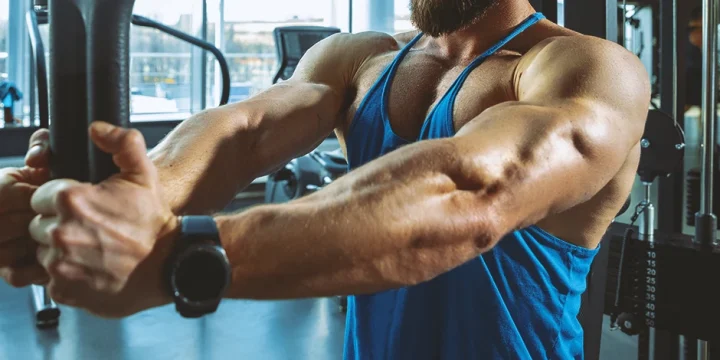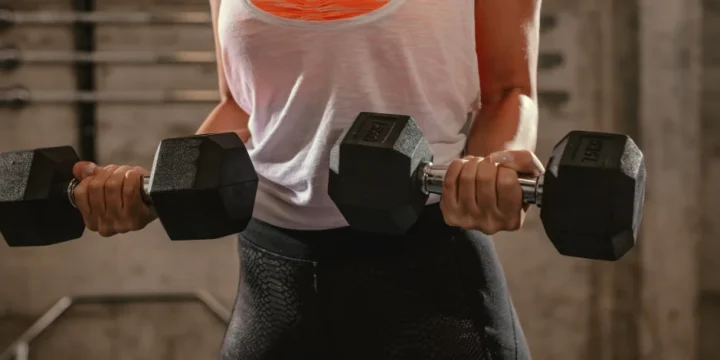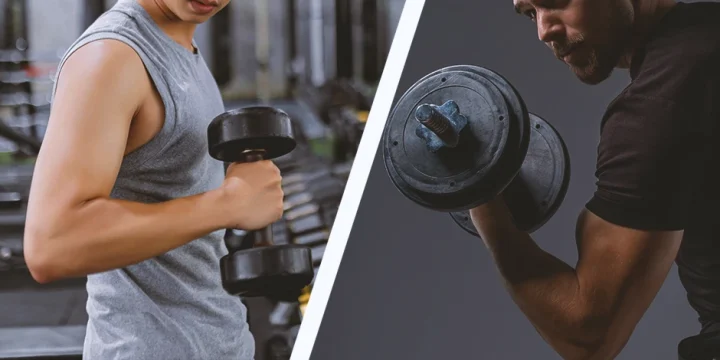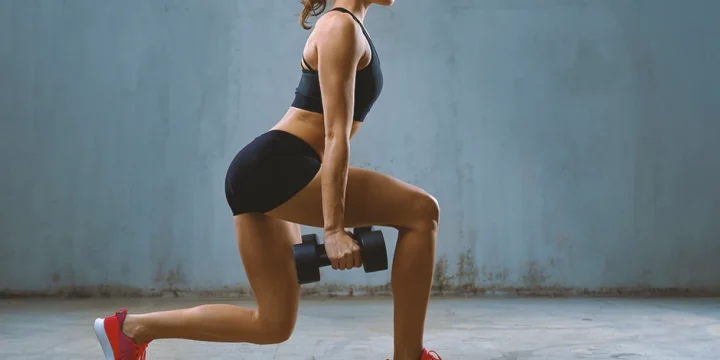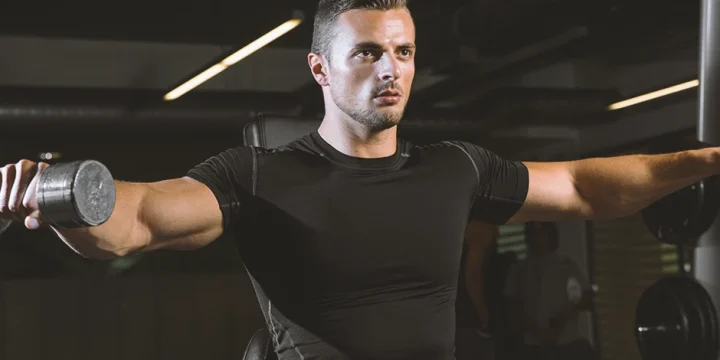As a certified personal trainer, I've meticulously researched and compiled the most effective bicep exercises for mass, ensuring you get the most from your workouts.
Building impressive biceps requires more than just standard curls; it calls for a diverse exercise regimen complemented by a well-structured diet. A key component of this is incorporating high-quality protein and the right supplements, especially best creatine supplements on the market.
This article, however, will focus primarily on mastering the best techniques across barbell, machine, and dumbbell exercises for optimal bicep hypertrophy.
Let's dive in.
Quick Summary
- To maximize muscle gain in the biceps, it's essential to engage in a variety of exercises, like barbell curls, cable curls, and chin-ups, combined with proper nutrition and supplementation.
- The ideal bicep workout should follow hypertrophy programming, focusing on 6–12 reps, a minimum of 4 sets, and short rest intervals.
- The principle of supercompensation, as detailed in the Canadian Journal of Applied Sports Science, emphasizes the need for sufficient rest, ideally 48 hours as recommended in the 2019 International Journal of Exercise Science study, to ensure complete glycogen replenishment in muscles.
- Over the years, seeing the progress of my clients, I've come to appreciate that individualized bicep workouts, tailored to specific needs and capabilities, yield the best long-term results in muscle mass increase.
Best Biceps Exercises for Building Muscle

To get the most out of every bicep workout and understand how to get bigger biceps, you must follow the hypertrophy programming recommendations of sticking to 6–12 reps, no less than 4 sets, and no longer than a 90-second rest interval between the sets, as defined in the study published in the International Journal of Environmental Research and Public Health [1].
Also, for every following workout session, you must use the principle of progressive overload, which means increasing the intensity of each next workout by changing the number of reps, sets, and external resistance [2].
However, according to the Sports Health research, if you fail to allow for proper recovery between two separate workouts, something called overtraining syndrome will likely occur, and your performance will drop [3].
This is because your body didn’t replenish the missing glycogen in your muscle cells.
This is scientifically called the theory of supercompensation or supercompensation of glycogen, as stated in the Canadian Journal of Applied Sports Science 1986 study [4].
That’s why I highly advise resting for at least 24 hours between the workouts, and if you want to be sure you supercharge glycogen in your muscle cells, stay at the recommended 48-hour rest period, following the 2019 study published in the International Journal of Exercise Science [5].
"Big biceps signal to the world that you’ve put in some serious sweat equity at the gym. The biceps are small muscles, but growing them takes time, knowledge, and intelligent programming. But the biceps don’t just look good — they serve a real function. The next time you pick up your kid or perform a perfect pull-up, that’s your biceps at work."
- Mike Dewar, Certified Personal Trainer
Lastly, don't avoid trying cheat curls for some sets. It can be viewed as a strategic variation from strict form that can effectively enhance your mass-building efforts by boosting mechanical tension.
Barbell or EZ Bar Curl
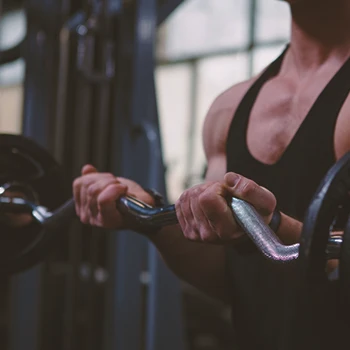
The barbell or EZ-bar curl is one of the most popular and efficient biceps exercises, targeting your upper arm pulling muscles.
How to Perform Barbell or Ez Bar Curls
- Load the EZ bar with sufficient weight to perform 10 consecutive reps without pausing.
- Take the normal supinated grip with your hands to hold the EZ bar from below.
- Assume a hip or shoulder-width stance with your feet, depending on your personal preferences.
- Start the exercise by curling the EZ bar upward towards your shoulder joints.
- When you reach maximum elbow flexion, hold that position for one second.
- Reverse the motion by slowly lowering and extending the elbow for added eccentric muscle contraction.
- Repeat for 10 reps, 3 sets, and rest for 60 seconds between the sets.
Related Articles:
- Top Barbell Exercises for Strength and Power
- How to Do Barbell Curls
- Best Barbell Shoulder Exercises
Cable Curl
Cable curls are an excellent alternative to regular barbells or EZ bar curls since they offer constant tension throughout the whole range of motion.
I've observed that beginners, especially, benefit greatly from this exercise, as it helps them maintain good form and develop muscle awareness.
How to Perform Cable Curls
- Load the cable machine with sufficient weight to perform 12 consecutive reps without pausing.
- Assume a regular hip or shoulder-width position before the cable machine and step back.
- Ensure the attachment is proper. I advise using a T-bar for starters.
- Start the exercise by curling the T-bar towards your shoulders.
- Hold the cable for one second when you reach maximum elbow flexion.
- Reverse the motion by lowering the cable, following an eccentric muscle regime, until you return to the starting position.
- Repeat for 12 reps, 4 sets, and rest for less than 90 seconds between the sets.
Related: How To Do Bicep Cable Curls
Dumbbell Curl

Dumbbell curls are a little more functional exercise option than the cable ones since they will require significant work from your stabilizer muscles.
How to Perform Dumbbell Curls
- Pick two dumbbells of the appropriate weight so you can perform eight consecutive reps without resting.
- Assume a shoulder-width-apart stance with your knees extended and dumbbells hanging from each hand.
- Ensure your back is flat during the whole duration of the exercise.
- Start the exercise by curling the dumbbells toward your elbow joints.
- Hold that position for one second when the dumbbell reaches the maximum amount of flexion, depending on your elbows.
- Reverse the motion by initiating a slow and controlled eccentric muscle contraction phase to return to the starting position.
- Repeat for 8 reps, 4 sets, and rest for 90 seconds between the sets.
Also Read: Best Dumbbell Biceps Exercises
Chin-up
Chin-ups may be a back exercise, but they are also excellent for targeting your biceps muscles due to the supinated grip.
If you're new to this exercise or want to ensure you're using the correct technique, check out the proper way to do a chin-up below.
How to Perform a Chin-up
- Assume a starting hanging position from the chin-up bar where the handles are parallel, so you place your shoulder in the neutral position.
- This means there is zero internal and external rotation in your shoulders.
- Start the exercise by pulling your chin towards the bar.
- Hold the top position for a 1-second isometric contraction when your chin reaches above the bar.
- Reverse the motion by lowering your body from top to bottom. You should force a slow, eccentric lowering portion to target your biceps muscles more efficiently.
- Repeat for 6 reps, 4 sets, and rest for 90 seconds between the sets.
Reverse-Grip Barbell Row
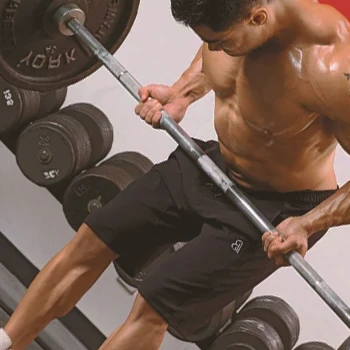
Rows, like chin-ups, are also excellent for targeting and developing functional strength in your biceps. This exercise has been a game-changer for my clients, particularly for those looking to enhance functional strength and muscle coordination.
However, the biceps will mainly work as the stabilizer component of the rowing motion and a little as a synergist, which is different from the last exercise.
How to Perform a Reverse-Grip Barbell Row
- Load the barbell with sufficient weight to perform upwards of 12 consecutive rows without resting.
- Assume standing in front of the bar with your shin close to the barbell, and ensure your feet are a little narrower than shoulder-width apart.
- Bend, take a reverse or supinated grip on the barbell, keep your back straight, and don’t cave in your knees.
- Lift the barbell off the floor and assume a starting rowing position with your hips bent forward to become as horizontal to the floor as possible.
- Start the exercise by rowing the barbell towards the intersection of your stomach and pubic area.
- When you reach the level of your stomach, hold that position for a 1-second isometric contraction.
- Reverse the motion by extending your elbows and bending your shoulders to return to the starting position.
- Repeat for 12 reps, 4 sets, and rest for 90 seconds between the sets.
Hammer Curl
Hammer curls are among the hammer curl variations that are a popular way of exercising your biceps today since they are quite effective for exercising all bicep muscles except the prominent biceps brachii.
How to Perform Hammer Curls
- Pick two dumbbells of appropriate weight so you can perform at least 10 hammer curls without resting.
- Assume a standing position hip-width apart and hold the dumbbells on the sides of your body.
- Start the exercise by curling the dumbbells in the neutral wrist position towards your shoulders.
- When you reach maximum elbow flexion, hold that position for one second.
- Reverse the motion to return to the starting position and repeat.
- Repeat for 10 reps, 4 sets, and rest for no more than 90 seconds between the sets.
Incline Curl
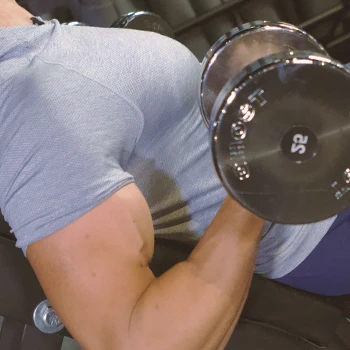
Incline curls are also a great bicep exercise variation since they will quite effectively target your biceps brachii due to the different angles of the movement.
How to Perform Incline Curls
- Pick two dumbbells of appropriate weight so you can perform at least 10 incline curls without pausing.
- Select the proper incline position on the adjustable bench so it closes the 45-degree angle with the imaginary line following the height of the bench seat.
- Let the dumbbells hang from your hands as you sit on the adjusted bench with your feet firmly placed on the ground.
- Start the exercise by curling the dumbbells towards your shoulders and flexing your elbows with maximum tension.
- Hold that position for one second when the dumbbells reach maximum elbow flexion.
- Reverse the motion by slowly lowering the dumbbells toward the starting position with a controlled eccentric contraction.
- Repeat for 10 reps, 4 sets, and rest for 90 seconds between the sets.
Concentration Curl
Concentration curls will effectively isolate your biceps muscles and let you focus on making the best muscle contractions to produce maximum hypertrophy effects.
How to Perform Concentration Curls
- Pick one dumbbell of appropriate weight so you can perform at least eight concentration curls in a row without resting.
- Sit on the bench and lay down your elbow on your quadriceps to enter the starting concentration curl position.
- Start the exercise by curling the dumbbell towards your shoulder without moving your elbow since it should be fixed on your quadriceps.
- When the dumbbell reaches the top position, close to your shoulder, hold that position for one second.
- Reverse the motion to return the dumbbell to the starting position by initiating the controlled eccentric contraction with your biceps brachii.
- Repeat for at least 8 reps, 4 sets, and rest for no more than 90 seconds between the sets.
Preacher Curl

Preacher curls are the staple biceps exercise that will effectively target and isolate your biceps brachii, brachialis, and brachioradialis.
How to Perform Preacher Curls
- Load the EZ bar with sufficient weight to perform at least 10 preach curls without pausing.
- Place the EZ bar in the preacher curl machine rack and assume a sitting position on the machine.
- Start the exercise by forcefully contracting your biceps muscles by curling the EZ bar towards your shoulders.
- When the EZ bar reaches close to your shoulders in the top position, hold it for one second.
- Reverse the motion by lowering the EZ bar towards the rack with a controlled eccentric portion of the movement.
- Repeat for 10 reps, 4 sets, and rest for 90 seconds between the sets.
Drag Curl
Drag curls are great variations of regular biceps curls where you can lift more weight by limiting the range of motion in the joints.
From my experience with clients, drag curls have been particularly effective for those struggling with traditional curl forms, offering a safer alternative that still provides substantial muscle engagement.
How to Perform Drag Curls
- Pick two dumbbells of appropriate weight so you can perform at least 10 drag curls without pausing.
- Assume a regular hip-width-apart standing stance and hold the dumbbells on the sides of your body.
- Slightly extend your shoulders to enter the drag curl starting position.
- Start the exercise by curling the dumbbells towards your shoulders until they reach the top position with maximum elbow flexion.
- Hold the top position for one second and immediately initiate the eccentric contraction by lowering the dumbbells to the starting position.
- Repeat for 10 reps, 4 sets, and rest for 90 seconds between the sets.
Rope Curl
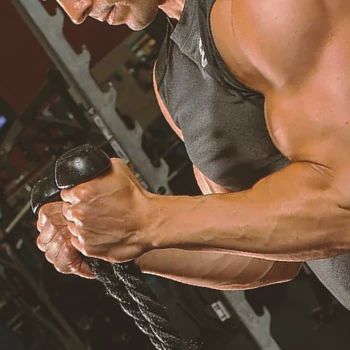
Rope curls are great for beginners since the cable machine offers sufficient stability and enables you to focus on your biceps muscles without using too many stabilizer muscles.
How to Perform Rope Curls
- Load the cable machine with sufficient weight to perform at least 12 consecutive rope curls without pausing.
- Assume standing in front of the cable machine and grabbing each rope end with one hand.
- Keep your back flat, knees slightly flexed, and hips neutral. Don’t use compensatory extending movements to perform more rope curls in your hips.
- Start the exercise by curling the ropes towards your shoulders.
- When you reach the top position of maximum elbow flexion, hold for a 1-second isometric contraction.
- Reverse the motion by slowly lowering the ropes towards the starting position with a controlled eccentric contraction.
- Repeat for 12 reps, 3 sets, and rest for as little as possible between the sets.
"Every bicep exercise will be slightly different based on where an individual’s current training levels are. In order to grow any area on the body, then there needs to be some form of progressive overload. For the biceps specifically, there are multiple ways you can progressively overload them for growth."
- Jake Boly, Certified Personal Trainer
Seated Cable Row
Seated cable row is a beginner back exercise, but it can contribute to better biceps growth since it can be loaded with significant weight.
How to Perform Seated Cable Row
- Load the cable machine with sufficient weight to perform 8 consecutive reps.
- Sit on the machine and place your feet on the pads so you have enough stability.
- Start the exercise by rowing the tripod or whatever attachment you use towards your stomach.
- Hold the top position for one second and reverse the motion to return to the starting position.
- Repeat for 8 reps, 4 sets, and rest for 90 seconds between the sets.
FAQs
How Can I Bulk up My Biceps Fast?
You can bulk up your biceps fast by exercising your biceps muscle groups regularly and consuming a high-quality protein powder. If you want to induce the most significant hypertrophy effects on your biceps brachii, you must train regularly, eat clean, and consume enough protein from supplements or lean sources daily.
Which Exercise Is Best for Bigger Biceps?
The best exercise for bigger biceps is an EZ-bar curl. EZ bar curls and exercises that allow a similar range of motion and starting position will build strong upper arms and bicep muscles if you perform them at least 2-3 times weekly.
How Fast Do Biceps Grow?
Biceps grow very fast. Depending on your training style and current diet regime, you can get your biceps noticeably bigger in a matter of weeks if you use proper intensity, training volume, rest intervals, and recovery between two different workouts.
Do Biceps Grow With More Reps?
If the biceps grow with more reps will depend on what you mean by more reps. The ideal range for hypertrophy and biceps growth is to use the rep range between 6 and 12 and choose the appropriate percentage of 1RM (maximum repetition), so you get the most out of every workout.
Is 7.5 KG Dumbbell Enough for Biceps?
Yes, 7.5 kg is enough for biceps if you can only perform upwards of 12 reps with the same weight. However, if you can perform more than 12 reps with a 7.5 kg dumbbell, you should take bigger weights since the ideal rep range for hypertrophy is between 6 and 12 reps.
References:
- https://www.ncbi.nlm.nih.gov/pmc/articles/PMC6950543/
- https://www.ncbi.nlm.nih.gov/pmc/articles/PMC4215195/
- https://www.ncbi.nlm.nih.gov/pmc/articles/PMC3435910/
- https://pubmed.ncbi.nlm.nih.gov/3698159/
- https://www.ncbi.nlm.nih.gov/pmc/articles/PMC6719818/
About The Author
You May Also Like
